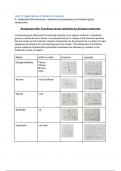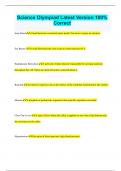Essay
BTEC Applied Science: Unit 14 learning aim A
- Course
- Institution
assignment A unit 14, distinction grade. which contains: A. D1 Analyse the types of reaction mechanisms undergone by non-carbonyl and carbonyl compounds. A.M1 Construct mechanisms for non-carbonyl and carbonyl compounds. A. M2 Plan a multi-step synthesis of carbonyl and non-carbonyl organic mo...
[Show more]





